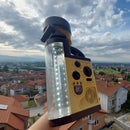Introduction: The World's Most Useless Vise?! - DIY Particleboard Moxon Vise
Hi Everyone,
Have I just built the world’s most useless vise? Well, it is a vise, it is made out of particleboard and it works. Read on to see how to build it.
Supplies
Tools and supplies used in the build:
Battery Drill - http://s.click.aliexpress.com/e/cmT6XhgM
Drill Bit Set - http://s.click.aliexpress.com/e/ccuczbyM
Speed Square - http://s.click.aliexpress.com/e/ccuczbyM
Combination Square - http://s.click.aliexpress.com/e/ccuczbyM
Wood Screws - http://s.click.aliexpress.com/e/ccuczbyM
Step 1: Introduction
Dating back to the 17th century, Moxon vises are first mentioned in the book "The Art of Joinery” from Joseph Moxon. They comprise two parallel wood surfaces with two screws on both sides to provide the pressure. Their common use is for working on an edge of a board for planing or working on the ends of boards, as in dovetailing
When designing my workbench, I wanted to have such vise available as so far I never had the ability to properly hold a board for planing or doing edge work. And since the entire workbench is made out particle board, I decided to give particleboard a chance as an experiment.
Step 2: Prepare the Vise Jaw
To provide some strength while clamping, I’ve used two pieces of particleboard that I’ve glued together and left them to dry while I continued working on the clamping mechanism.
Step 3: Prepare the Clamping Mechanism
To prepare the screws, I’ve cut an M8 threaded rod in half with a cut-off disk in my angle grinder and used the disc to make chamfers on the cut pieces. This will allow the screw to be started a lot easier when threading.
To add a handle to the screws, I clamped it down to my workbench and I welded a nut at the end of it, with the hole perpendicular to the screw. This will allow me later to insert another smaller screw as a handle to be used for spinning the screw.
At their ends, I’ve locked two nuts together so the source of the clamping force is not the nut I’ve welded but slightly before it. This should prevent too much stress on the welded nut.
Step 4: Prepare the Mounting Holes
To mount the vise to the workbench, I’ve drilled two holes in the side piece at 15cm from the ends of the clamping jaw. This should be enough to provide distance in between the screws so a board can be fit upright.
Then, on the inside of the workbench, I’ve installed two threaded inserts in the holes I just made and once the glue was dry on the jaw, I made the same holes there as well. Here I made the holes slightly bigger and this was a mistake. If I ever redo the jaw, I’ll only add slack horizontally in order to prevent the jaws from twisting up and down while clamping.
Step 5: Mount the Jaw
I’ve slid a big washer next to the locking nuts and then added the vise jaw. The entire thing is then mounted to the workbench, where I’ve used a twisted nail to grip the nut at the end and thread the rod a lot faster than by just turning by hand.
Step 6: Testing the Vise
To test the vise, I’ve used a pallet board to first insert it upright, and the vise holds it perfectly fine. I was not able to move the board even while banging with a wrench on it. Depending on the force you gonna apply on the screws, the jaw bends a little bit, but by using some common sense and limiting the force, it should hold up and not break.
In the horizontal position, the vise is even better since it now clamps along the entire width. I was able to use a plane on the edge of the board without any issues with quite a lot of force. It is only when a board is mounted face-up that the vise isn’t that good and the vertical play comes into view but I think I’ll be able to solve this later on by adding a bigger washer before the clamp screws.
I hope that you liked this experiment and that you will try it on your workbench. If you have any questions, let me know in the comments and don’t forget to subscribe to my YouTube channel for more projects in the future.











